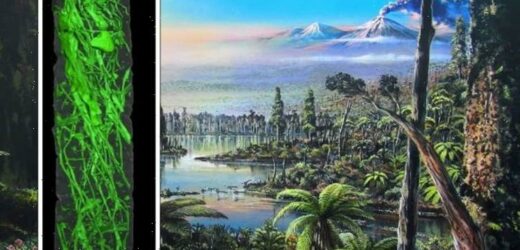Antarctica: Scientists find area where no life exists
We use your sign-up to provide content in ways you’ve consented to and to improve our understanding of you. This may include adverts from us and 3rd parties based on our understanding. You can unsubscribe at any time. More info
Antarctica is the Earth’s fifth largest and most southerly continent. With temperature often dropping below -90C, it is one of the most inhospitable places on the planet, with only the most hardy of lifeforms able to survive. This hasn’t stopped humans from venturing to the barren land, with anywhere between 1,000 and 5,000 people living there.
The wonders of adaptation have led to a thriving wild animal population, with around 235 different species calling Antarctica home.
While the Antarctica of today is nothing more than a desert of ice, previous research suggests that the region was once a hotbed of life and a temperate forest.
The breakthrough discovery was made after a mission found fossilised plant roots preserved under the ocean since the time of the dinosaurs.
Explored during the science journal Nature’s short documentary, ‘An ancient Antarctic rainforest’, the narrator noted: “It seems this freezing landscape was once home to a lush forest.”


Johann Klages, a scientist from the Alfred Wegener Institute in Germany who led the research, said: “90 million years ago, a temperate rainforest existed in West Antarctica only 900 kilometres away from the South Pole.”
He and his team found the evidence after setting out with a special drill to extract a core of material stretching down 30 metres into the sea floor in 2020.
The discovery was unprecedented: they found that the annual mean temperature of a strip of western Antarctic coastline was 12 degrees.
This would have made for a landscape of swampy rainforest.
JUST IN: Ancient Egypt breakthrough after discovery of prehistoric cemetery

He said: “When we recovered the core, we could already see what was inside and that it was very unusual.
“And therefore we decided to scan them in a CT scanner back home.”
A visualisation of what the scientists found is shown, with a long, green and yellow thread-like material revealing the different properties of the item found within the ice.
Mr Klages said: “So what we see there is the overview of the CT-scanned core and the yellow strata that we see is the sandstone, and now we transition into the network of fossil roots.
DON’T MISS
Archaeologists stunned by 5,000-year-old ‘Scottish Pompeii’ settlement [REPORT]
Stonehenge breakthrough as chalk plaques depict found to real objects [INSIGHT]
EU revolt as VDL told to ‘immediately accept’ UK into project [ANALYSIS]


“We can nicely see how the roots are connected with each other and are pristinely preserved.
“We have thin roots, we have thick roots, and it’s really a network as you would go to the forest near you and drill into the current forest.”
Studying the core, including analysis of fossilised pollen and spores, even more information about the environment of the ancient rainforest was offered.
Mr Klages explained: “It revealed a very warm temperature for this latitude, and annual mean temperatures that are similar to those of Northern Italy.

“It would be very certain that also dinosaurs and insects lived in that environment, and in an environment that was dark for about four months during the year because we have the polar night.”
This was one of the warmest periods in Earth’s history.
Carbon dioxide levels were several times higher than they are today.

Mr Klages hopes that studying the past extremes could potentially help us prepare for the future.
This is because it allows a brief view to the future of what the planet might look like if we continue excessively emitting CO2.
Source: Read Full Article


